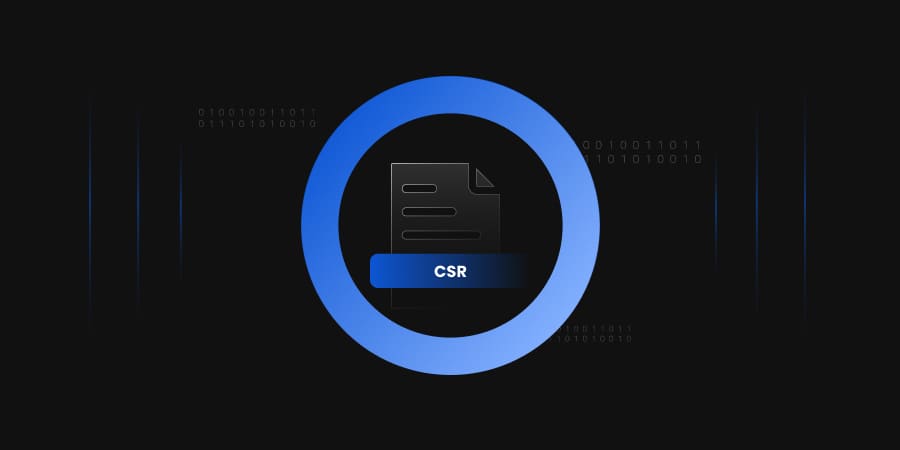Imagine you’re applying for a passport to travel to a foreign country. Before you get that passport, you need to go through an application process and provide some key information. Similarly, in the digital world, a CSR is like a passport application for a digital certificate. Now, you must be wondering, What is a CSR, and what does it stand for? A CSR is a small, encrypted file you generate on your computer or server to obtain a digital certificate from a trusted Certificate Authority (CA).
The Elements of a CSR
Think of CSR as a digital form you fill out when applying for a certificate. You can use a CSR to generate SSL/TLS certificates. It contains essential information that proves your identity and establishes the legitimacy of your online presence. Here’s what a typical CSR components are:
| Element | Description | Example |
| Common Name (CN) | The primary domain name for the certificate. | www.encryptionconsulting.com |
| Organization (O) | The legal entity’s name is the one to which the certificate is issued. | Encryption Consulting |
| Organizational Unit (OU) | A specific department or division within the organization (optional). | Security |
| Locality (L) | The city or locality where the organization is located. | Dallas |
| State or Province (ST) | The state or province where the organization is located. | Texas |
| Country (C) | The two-letter CSR country code where the organization is registered. | US |
| Email Address | An email address is needed to contact the certificate requester. | [email protected] |
The CSR Process Simplified
-
Generate a Key Pair
You need to create a key and a private key pair for the certificate request before creating a certificate signing request(CSR). The certificate’s private key should be kept secret, while the public key is included in the CSR.
-
Create Certificate Request (CSR)
Using your private key, you generate a certificate signing request, which includes your public key and the necessary details required for the certificate, such as your domain and organization information. You can also create a CSR online using OpenSSL (SSL certificate request) or any other certificate signing request generator. To verify every attribute is set properly, you should read the CSR file once.
-
Submit CSR to CA
The CSR is then sent to a trusted CA for certificate issuance and to sign the certificate request. If you want to have a self-sign certificate, you can get the CSR signed by a Windows CA (using the command – certreq submit csr), too.
-
CA Verification
Once the CSR has been generated and forwarded to the CA, the CA initiates a verification procedure before granting the certificate. The specific verification steps undertaken vary based on the certificate type requested by the complete certificate request body.
-
For Domain Validated (DV) Certificates
The CA performs a relatively simple check to verify that you have control over the domain. This may involve methods like email verification or DNS record updates.
-
For Organization Validated (OV) Certificates
The CA conducts a more extensive verification process. They verify your organization’s legal existence, physical address, and other business details through documents and public databases to confirm its legitimacy.
-
For Extended Validation (EV) Certificates
EV certificates undergo the most rigorous verification. The CA thoroughly checks the organization’s legal status, physical presence, and ownership. They also validate that you have the right to represent the organization. EV certificates provide the highest level of trust and assurance and display the organization’s name prominently in the browser’s address bar.
-
Certificate Issuance
If the CA successfully verifies the required criteria, it issues the corresponding certificate: DV, OV, or EV.
-
Certificate Installation
Finally, you install the issued certificate on your server. The level of trust and validation provided by the certificate (DV, OV, or EV) depends on the verification process performed by the CA.
Conclusion
Certificate Signing Requests (CSRs) might sound complex, but they’re essentially your way of asking a trusted authority to vouch for your digital identity. CSRs enable secure and trustworthy online interactions. So, the next time you see that padlock symbol or “https” in your browser’s address bar, remember that a CSR played a part in ensuring your online safety.
How can Encryption Consulting help?
Encryption Consulting provides a specialized certificate lifecycle management solution for CertSecure Manager from discovery and inventory to issuance, deployment, renewal, revocation, and reporting. CertSecure provides an all-encompassing solution. Intelligent report generation, alerting, automation, automatic deployment onto servers, and certificate enrollment add layers of sophistication, making it a versatile and intelligent asset.

